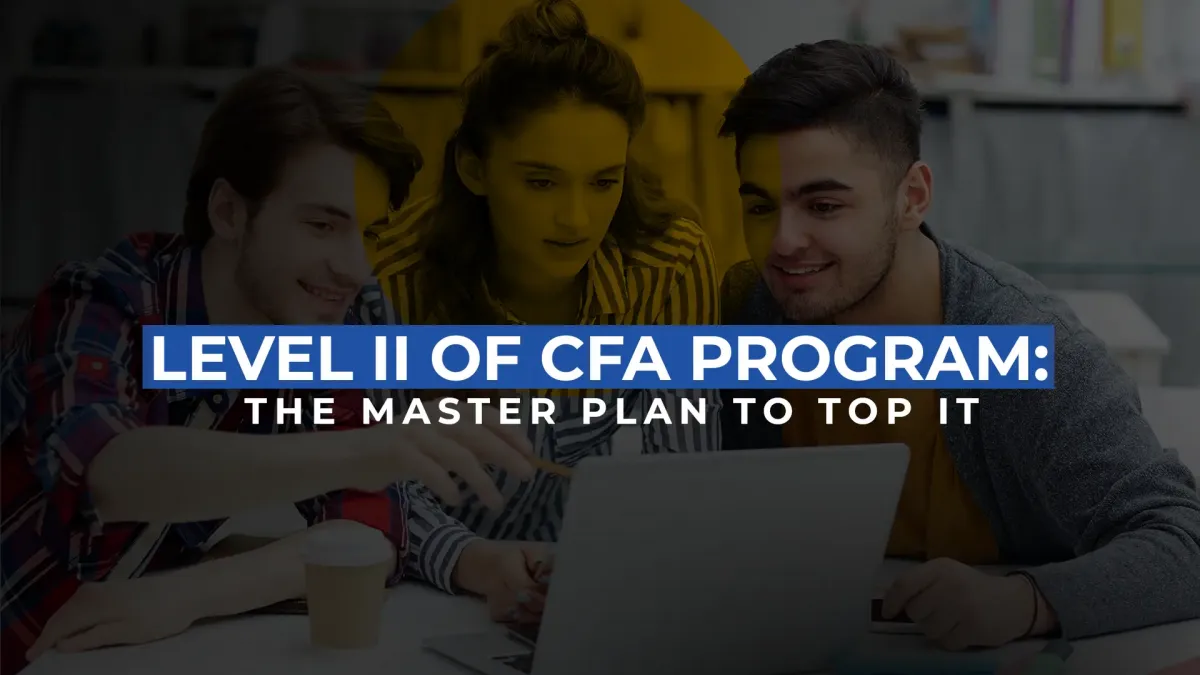Since you’re reading this blog there is a strong possibility that you’ve already begun your journey to becoming a Chartered Financial Analyst. Well, we all are aware that CFA is no ordinary path. And right at the heart of this rigorous journey lies the CFA Level 2 exam which is an intimidating challenge that we’re going to cover thoroughly in this blog.
Whether you’re a CFA Level 1 survivor or just setting foot on this route, this blog could be your compass to exploring the CFA Level 2 exam format with confidence. This level tests your investment management and portfolio ideas in detail and assesses your capacity to apply these concepts to practical situations.
In fact, did you know that 2023 is ringing in some notable changes to the CFA Level II curriculum? Well, don’t worry as we’ll be breaking down those updates, zeroing in on the exam format, and shedding light on the CFA Level II pass rate that keeps you awake at night. We will cover everything from derivatives to equity investments and from financial reporting analysis to ethics. So you can better comprehend the intricacies of the CFA Level II exam by reading this blog as our syllabus spotlight is here to guide you through the topics that will dominate your study sessions.
Get ready to demystify the CFA Level II exam format and understand the complexities and strategies of CFA together. After all, conquering Level II brings you one step closer to earning that coveted CFA designation which is a badge of honor in the world of finance.
Understanding CFA Level 2
You might be thinking, “What does the CFA Level II exam test, other than your patience?”
Well, this test will cover the following:
Asset Classes and Valuations:
- Proper knowledge of equity and fixed-income securities is crucial.
- Candidates must thoroughly practice the various valuation methods and risk assessments.
- Proficiency in alternative investments (private equity, real estate, hedge funds) is tested, including their unique valuation techniques.
Application of Tools and Techniques:
- Candidates must use quantitative techniques to analyze investments, including statistical analysis and forecasting.
- The application of portfolio management theories, strategies, and performance measurement is essential.
Ethics and Professional Standards:
- Building on Level I, candidates must navigate ethical dilemmas in investment decision-making.
- The Code of Ethics and Standards of Professional Conduct is a fundamental component that emphasizes fiduciary duty and professionalism.
Financial Reporting and Analysis:
- A deeper financial statement analysis is required, including understanding how different accounting methods affect financial ratios and valuations.
Do you know why everyone says that passing the CFA Level II exam is a major milestone on the path toward earning the CFA degree?
- CFA Level II serves as a bridge to Level III, which focuses more on portfolio management and wealth planning.
- Clearing this level enhances your credibility as a knowledgeable investment professional and improves your employability prospects.
- The subjects of Level II deepen your understanding of asset classes, valuations, and portfolio management techniques that will be helpful in the next level.
So even though the CFA Level II exam is challenging it really helps you in the long run.
Want to learn from some of the best CFA charter-holders & IIM Alums?
CFA Level 2 Curriculum Changes 2023
The CFA Institute regularly updates its curriculum to ensure that this exam remains relevant and aligned with the evolving trends in the finance industry. So staying updated with these changes is crucial because:
- Exam relevance
- Effective preparation
- Better scoring
- Avoiding surprise
- Maintaining credibility
So to ensure you’re up-to-date with any modifications to the CFA Level II syllabus keep these points in mind:
- Check the CFA Institute’s Website regularly
- Monitor Communication Channels
- Consult with Professors from premium institutions like IMS Proschool
- Participate in Review Courses
Are you aware of the buzz around CFA 2023 curriculum changes?
- The changes in 2023 mostly revolve around two key areas: Quantitative Methods and Alternative Investments.
- These sections have been meticulously broken down into smaller learning modules, making them easier to grasp and master.
- FRA is now known as Financial Statement Analysis, or FSA, and Corporate Finance is known as Corporate Issuers.
- There are 49 modules in the 2023 level 2 CFA exam curriculum (vs. 47 readings in 2022). One reading has been removed and four readings were added.
- 6 readings include updates
- Multiple Regression in Quantitative Methods, Corporate Restructuring in Corporate Issuers, and Real Estate Investments in Alternative Investments just have some significant changes.
The world of finance is ever-evolving, and so is the CFA curriculum. So, now you have all the updates on the recent curriculum changes for CFA Level II in 2023.
In fact, if you’re interested in enrolling at an institution that offers a curriculum aligned with the 2023 updates then check out IMS Proschool’s CFA Level 2 course. They even start a new batch each month and offer outstanding in-person classes across 10 different cities.
CFA Level II Exam Format
In this section let’s understand the details of the CFA Level II exam format.
- CFA Level II exam consists of 22 item sets that include vignettes and 88 related MCQs.
- The test takes place over the course of 4.5 hours and is divided into two equal periods of 2 hours and 12 minutes each.
CFA Exam Format:
- This exam is standardized with 11 item sets for each session.
- MCQs in each item should be answered based on the information given in the vignette. Therefore, the items are not free-standing, as in the CFA Level I exam. Candidates will need to refer to the vignette before answering each item.
Now let’s look at more details about the types of questions, including item sets and vignettes, in the CFA Level II exam.
Item sets, also known as vignettes, are a distinctive feature of the CFA Level 2 exam-
- Each item set presents a scenario or case followed by a series of questions related to that scenario.
- The questions within an item set cover various concepts and require candidates to apply their knowledge, analytical skills, and critical thinking to answer accurately.
Unlike the Level I exam, where each question is standalone, the Level II exam focuses on testing your ability to synthesize information and apply it within a contextual framework.
Do you know how the CFA Level 2 exam is different from Level I?
- Level II questions demand application, analysis, and synthesis of knowledge, rather than just recall.
- The questions are case-based due to the vignette format. Candidates must read and understand the entire scenario to answer the related questions effectively.
Here are some tips to manage all these changes for effective time management during the exam:
- Practice with Timed Mock Exams
- Allocate Time Per Item Set
- Focus on high-point questions
- Apply some shortcut techniques
By applying these tips to your plan you’ll be better able to manage your time efficiently and perform well.
Preparing CFA Level 2 seems difficult on your own? Let us help you design a Custom Learning Plan for your CFA Level 2 exam
CFA Level 2 Pass Rate
Since the CFA test has 3 levels of difficulty, it has a poor pass rate. But don’t worry because in this section we’ll talk about how you can improve your chances of passing.
The average Level II pass rate is around 46%. However, the latest pass rate was the first time since 2020 that the pass rate exceeded 50%.
- February 2021: 46% pass rate
- May 2021: 40% pass rate
- August 2021: 29% pass rate
- February 2022: 44% pass rate
- August 2022: 40% pass rate
- November 2022: 44% pass rate
- May 2023: 52% pass rate
Insights from Pass Rate Analysis:
- The pass rates have varied significantly ranging from a low of 29% to a high of 52%. This indicates that the exam’s difficulty and a candidate’s performance can vary widely.
- There’s no consistent pattern between the exam sessions. Pass rates have fluctuated across different sessions, suggesting that the exam’s complexity is not tied to a particular timeframe.
So here are some strategies to increase your chances of passing the CFA Level II Exam –
- Begin your preparation well in advance to have ample time for understanding complex concepts and repeated practice.
- Identify topics that have a lower pass rate and focus on them.
- Familiarize yourself with the item set format and practice extensively with mock exams.
- Use active learning techniques, such as teaching others or explaining concepts to yourself.
Remember that while pass rate trends can offer insights, your success ultimately depends on your dedication and ability to apply effective study strategies. So by learning from historical data and adapting your approach, you can increase your chances of passing the CFA Level II exam.
Did you know that IMS Proschool boasts an impressively high passing rate for the CFA exams? They even extend an exam pass commitment to their students! In fact, studying here not only ensures your successful passage but also increases your chances of securing a job immediately after completing Level 1.
Don’t trust us? Well over 84% of their students enrolling for CFA courses recommend others to join it too. So do check out IMS Proschool’s CFA Level 2 Course.
CFA Level 2 Syllabus
In this section let’s give you a comprehensive overview of the CFA Level II syllabus.
Out of the 10 subjects that make up the curriculum here are the four main sections of CFA Level II. Let’s understand the specific focus of each section in the CFA Level II curriculum:
Professional and Ethical Standards:
- This section builds upon the foundation laid in Level I.
- Students are expected to understand how to apply these standards in various scenarios like responsibilities towards clients, employers, and the broader financial community.
- This section focuses on the importance of having integrity, transparency, and accountability in any finance profession.
Finance Instruments:
- It focuses on the detailed characteristics such as valuation methods and risks associated with various financial instruments.
- It includes a detailed study of equity and fixed-income securities and advanced valuation techniques such as discounted cash flow models and option pricing models.
- The focus is on understanding how different instruments contribute to investment portfolios and their use to manage risk and enhance returns.
Asset Types:
- Here candidates further develop their knowledge of different asset classes.
- Candidates get to learn about the factors affecting asset returns, risk considerations, and the impact of macroeconomic factors on asset performance.
Portfolio Management and Wealth Planning:
- It covers the practical aspects of portfolio management like portfolio construction, performance evaluation, and risk management.
- It even addresses wealth planning concepts like tax-efficient investing, estate planning, and the various strategies to meet clients’ financial goals.
All these sections in the CFA Level II curriculum are designed to showcase shifts from foundational concepts to advanced applications and analyses.
Now that you have an idea about the syllabus of CFA Level II make sure to follow these points to approach and effectively study the syllabus considering its depth and complexity
- Break down each LOS into smaller components and make sure you can explain and apply each aspect.
- Use Official CFA Institute Materials
- Given the exam’s focus on item sets, practice answering questions in this format.
By using these specific strategies, you can approach the CFA Level II syllabus in a systematic and effective manner.
Master Plan to Top CFA Level 2
Here’s a detailed guide to get you on the right track:
-
Organize Your Study Materials:
- Gather all your study materials, including CFA Institute readings, study guides, and practice questions.
- Create folders or binders for each study session, topic, or reading.
-
Set Realistic Study Goals:
- Set specific goals for each study session, whether it’s completing a reading or mastering a specific concept.
- Break down the syllabus into study sessions based on the Learning Outcome Statements.
-
Create a Detailed Study Schedule:
- Develop a week-by-week study schedule that covers all the topics within the available time.
- Prepare a detailed study schedule for challenging areas.
- Allocate more time for topics like Fixed Income, Derivatives, and Portfolio Management.
-
Consistent Routine:
- Decide on a study routine that suits your daily schedule, whether it’s mornings, evenings, or weekends.
- Determine your most productive study times and stick to a consistent routine.
- Plan for focused study sessions that allow time for review and practice questions.
-
Focus on Understanding
- Approach the material with the aim of deeply understanding the concepts.
- Prioritize comprehension over rote memorization of topics
- Relate new concepts to practical examples and real-world scenarios.
Did you know, 84% of our students suggest that you join us for your CFA Journey!
-
Active Learning Techniques
- Summarize readings in your own words to reinforce your understanding.
- Teach concepts to a study partner or even to yourself as if you were instructing someone else.
- High-priority topics: Focus on Equity Investments, Fixed Income, Derivatives, and Ethics.
-
Practice
- Regularly solve practice questions and problems related to the material you’ve covered.
- Take mock exams to get a feel for the item set format.
- Online platforms like IMS Proschool can offer a very well-prepared question bank that is tailored to each CFA Level II topic.
-
Review Regularly:
- Set aside time for regular review sessions to reinforce your memory.
- Use spaced repetition techniques to revisit material over time.
- Use flashcards or notes summarizing key formulas and concepts.
-
Adapt Your Strategy
- Based on practice exam results, adjust your study plan to focus on areas needing improvement.
- Target additional practice questions on specific sub-topics to reinforce your understanding.
- Don’t be afraid to revisit topics you’ve studied if you encounter them in weaker sections.
-
Manage Time:
- During practice exams, monitor your time per item set to ensure you’re within the allocated time.
- Train yourself to move on from difficult questions and return to them if time permits.
-
Maintain Balance:
- Remember to balance your study routine with breaks, exercise, and sufficient sleep.
- Having a healthy mind and body contributes to effective learning.
Remember, that the CFA Level II exam demands in-depth understanding and application. So with diligent efforts and a well-structured plan, you can ace the complexity of Level II and set yourself up for success.
Additional Resources and Study Tools
To defeat the challenges of CFA Level II exam, it’s important to recognize the value of a well-prepared study approach. While the official CFA Institute curriculum forms the foundation of your preparation using supplementary resources can provide additional insights and perspectives to enhance your understanding and increase your chances of success.
In this section, we’ll look into some useful resources that can complement the official curriculum and highlight the merits of enrolling in premium institutions like IMS Proschool that offer various advantages for your CFA Level II preparation.
Here are some additional resources:
- Online Study Platforms
- Video Lectures
- Practice Question Banks
Using all these resources will definitely be helpful but nothing can beat enrolling in premium institutions like IMS Proschool which can significantly enhance your preparation. Want to know how?
- IMS Proschool has a faculty team from top institutions like IIMs and IITs. Their faculty also includes CFA charter holders who can offer valuable industry-based insights to students.
- The institution is committed to providing the most current and relevant study materials based on the updates of March 2023.
- They even focus on topics like the inclusion of Financial Modeling and Python training that can provide an extra edge to candidates.
- With over 250+ Hours of Training, IMS Proschool provides a comprehensive coverage of the curriculum.
When considering additional resources make sure to check out IMS Proschool’s CFA Level 2 Program and increase your chances of excelling in the CFA Level II exam.
Exam-Day Tips and Strategies
Preparing for the CFA Level II exam isn’t just about mastering the content, it’s also about executing your knowledge effectively on exam day.
Here are some strategies to help you ace exams with confidence:
- Arrive Early
- Stay Calm
- Read the Instructions Carefully
- Allocate Time Wisely
- Focus on Vignettes
- Tackle the Easier Questions First
- Review Answers
- Stay Positive and Confident
- Avoid Comparing with Others
- Stay until the End
On the final day make sure to just trust your preparation and believe in your abilities because that’s the ultimate key to passing this exam.
Conclusion
In the race to become a CFA charter holder, the Level II exam has its unique challenges and rewards. Throughout this guide, we’ve explored the strategies and insights that can help you explore this critical phase.
So, make sure to remember that this exam demands a deep understanding of complex topics and you must approach the curriculum with dedication. While the official CFA Institute curriculum forms the foundation you must consider premium institutions like IMS Proschool that offer a unique opportunity for you to learn from the experts in the CFA domain.
Remember that every step you take today brings you closer to your goal of joining the prestigious community of CFA charter holders. The CFA Level II exam is not just an obstacle to overcome but a stepping stone toward your future success in the financial industry.
Begin your preparation, stay focused, and let your dedication light the path to your CFA charter.








Leave A Comment